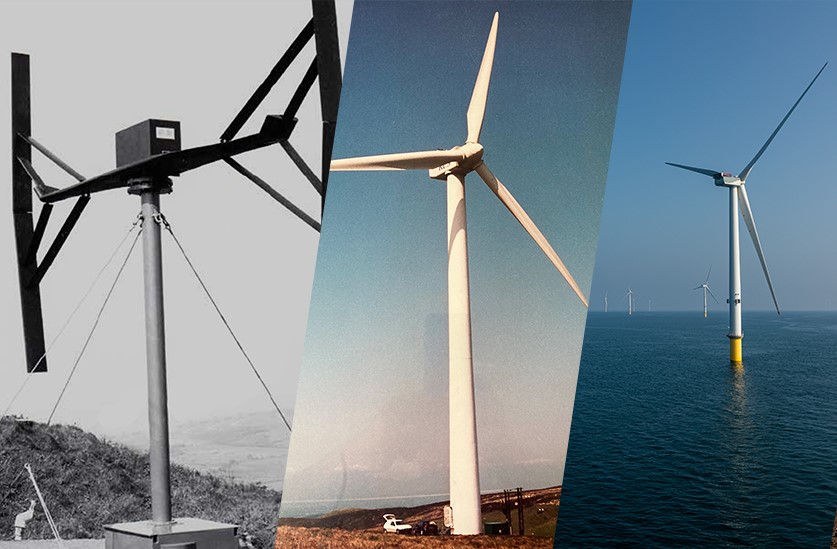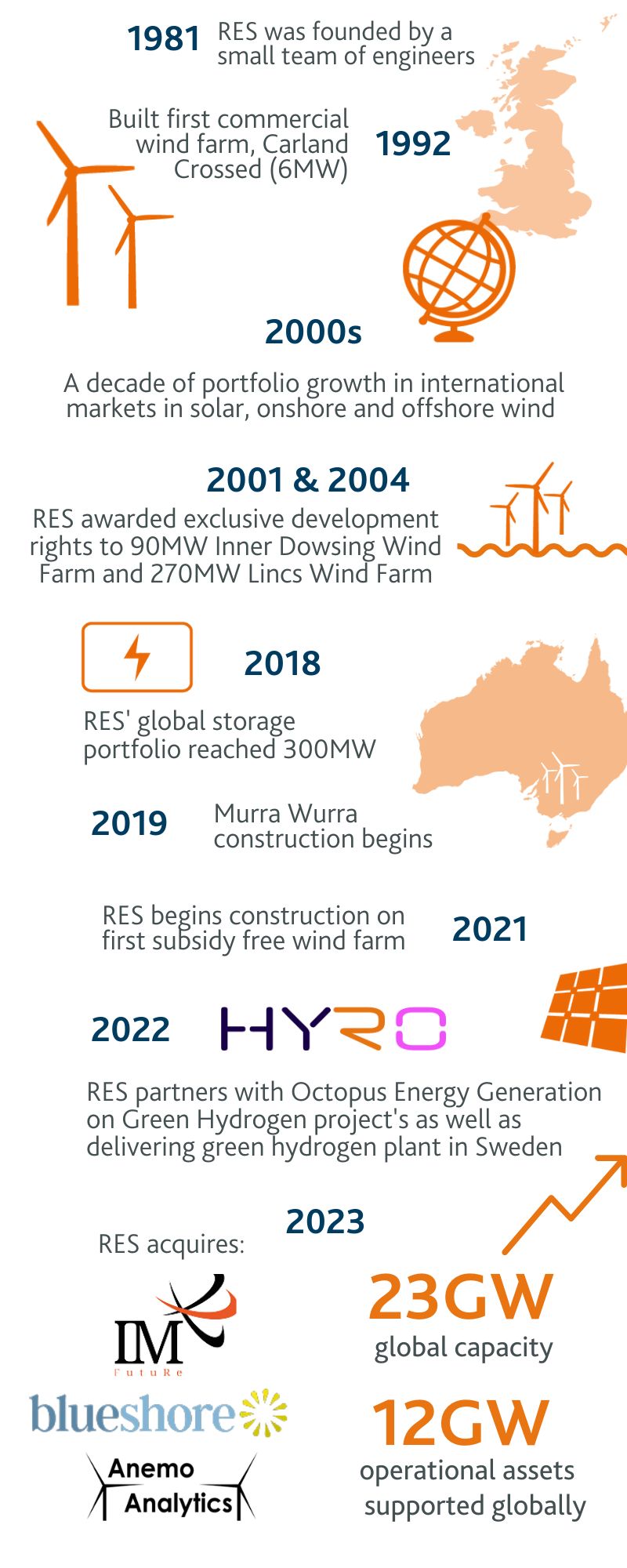Reflecting on how far the renewables industry has come
by RES | Mar 01, 2023 | Temps de lecture: 6 min

RES started its journey into renewables in 1981, born from a small special projects team and group of wind energy pioneers undertaking research into wind turbines. Over the past 40 years we have grown substantially and now employ 2,500 people across 13 countries. Reaching the milestone of 12GW of operational assets supported globally, we reflect on just how far the industry, and RES, has come in that time.![]()
Established in 1981, RES was born from a small team of engineers who had been working on a new kind of wind turbine that the UK Government hoped could be eventually deployed in offshore wind farms, moving the country away from its dependence on increasingly costly fossil fuels. When the UK government announced support for the first phase of commercial wind farms in the early 1990s, RES had the ideal opportunity to put our years of knowledge and experience into practice.
Throughout the 1990s and 2000s when renewable energy was just a pipe dream to many, RES’ renewable energy portfolio quietly began to grow as the rest of the world was just beginning to learn what fossil fuels and CO2 emissions were. As the world became aware of climate change RES had already learnt much and moved beyond designing turbine technology and onto developing wind and solar projects. In 1992, we built our first commercial wind farm, the 6MW Carland Cross project in Cornwall. This was only the second wind farm to be constructed in the UK at the time. Operating this site was also the start of bigger things to come for our support services business.
A decade of growth
The 2000s was a decade of growth for the international industry. Globally, the wind power market grew, generating $7bn in revenue in 2001. In 2006, wind power production exceeded 74GW and in 2009 wind energy provided 2% of the total global electricity usage.
For RES, this was also a time of portfolio growth within international markets in both onshore and offshore wind and solar developments across the UK&I, North America, Europe and Australia. Throughout this period, a series of record-breaking developments secured RES’ position as an industry leader. This included the largest wind project in the world at the time, the 278MW King Mountain Wind Farm in Texas completed in 2001 and the largest wind projects in France and Ireland, Souleilla-Corbières project (20.8MW) and Altahullion project (26MW) in 2002 and 2003 respectively.
With regards to offshore wind, in 2000, The Crown Estate initiated a series of leasing rounds in the UK, awarding offshore development rights cumulating in capacity of 41GW. Overnight, this effectively positioned the UK as the leading contributor to the offshore wind energy market. Amidst the offshore boom, RES was awarded exclusive development rights for our first two offshore wind projects, the 90MW Inner Dowsing Wind Farm in 2001 and the 270MW Lincs project in 2004 both located off the Lincolnshire coast in England.
The renewables boom
2018 witnessed the global boom of renewables due to several factors including the cost reductions of renewables, improvements in technology, an accelerated expansion in capacity as well as favourable government policies demanding energy security by consumers and competitive advocation for climate change and a transition to clean energy.
With respect to onshore wind, in Australia we commenced the construction of the first of two wind farms called the Murra Wurra Wind Farm Project in 2018. With Murra Warra I completed in 2020, the second wind farm, Murra Warra II is due for completion in 2023. The project, once fully completed, will be one of the largest wind projects in the southern hemisphere at 429MW.
In 2019, we began construction on our first subsidy free wind farm, Craiggore. This was a major milestone for RES and the wider renewables industry, where it is possible to deliver decarbonisation at the lowest cost for consumers, independent of government backing. Looking ahead, a revolution may be on the horizon for the renewable industry as merchant projects, which were once out of reach, are paving the way and can drive decarbonisation at lower costs via market influence. In some ways we believe the sky’s the limit as onshore wind is the cheapest form of generation.
Growing our support services
To facilitate the migration into battery storage projects, in 2013 RES developed our in-house state-of-the-art energy storage management software system providing 24/7 management of the battery’s operation maximising potential revenue streams for clients. By 2016, we had already developed battery storage projects in Canada and the United States and began actively progressing opportunities across the UK capitalising on expertise gained in North America. In 2018, our energy storage portfolio grew to 300MW following the energization of Broxburn Energy Storage site. By 2019, cutting-edge digital technology like RESolve was being applied to renewable assets to improve efficiency, yield and revenue.
In 2019, we acquired the asset management division of REG Power Management, increasing our operations market share to 5GW globally. In the same year, a report by DNV, found that assets managed by RES perform 1% better than industry standard.
Over this period, our support services team had grown significantly and was achieving success. For instance, in 2021, Emerald Solar Farm managed by our Australian team, was identified as the top performing solar farm in Queensland with the highest capacity factor in the State, according to recent analysis by the independent energy research and business intelligence company, Rystad Energy. In the UK, we were named as the fastest growing solar operations and maintenance (O&M) provider in a report published by global research and consultancy business Wood Mackenzie at that point doubling solar O&M portfolio to over 400MW. In 2021, we also announced our acquisition of Blueshore, an asset management business with 1.6GW of assets under management in Australia. The move meant that globally, we now supported over 9GW of operational wind, solar and storage assets and are one of the few companies able to provide a wide array of services on a large international scope.
Accelerating the net zero transition
Fast forward to 2021, the year when the UK welcomed the 26th United Nations Climate Change Conference (COP26). Positioned just a matter of meters away from the epicentre of climate change negotiations, RES had a front row seat at COP26 taking the opportunity to weigh in on the discussions surrounding the necessary collaboration of governments and stakeholders in the deployment of renewables and critical conversations such as the generation of grid and the future of green hydrogen.
In 2021, we announced a partnership between RES and Octopus Energy Generation which outlined the intention to boost the UK’s green hydrogen economy by delivering a home-grown, reliable, cost-competitive source of green hydrogen with an investment of £3 billion to build new green hydrogen plants across the country by 2030. Following this, a collaboration between RES and Ånge Municipality in Sweden was also confirmed to deliver a new green hydrogen plant supplying and generating more local industry and creating new jobs alongside decarbonising industrial businesses.
How far we’ve come
The growth of the global renewables market has been astounding, with wind power being one of the biggest industrial success stories in the past quarter of a century. McKinsey’s 2022 Global Energy Perspective report estimates that by 2026, global renewable-electricity capacity will rise more than 80 percent from 2020 levels (to more than 5GW). Of this growth, two-thirds will come from wind and solar, an increase of 150 percent (3.4GW). By 2035, renewables will generate 60 percent of the world’s electricity, but with a caveat that these predictions may be inferior to the reality.
From designing our 1MW turbine in 1998, through to using GPS mapping (seven years before Google Earth), we are always looking for new ways to advance our industry. Now, with the digitilisation era of renewable energy upon us, we are empowering our market position by harnessing advanced technology to lead the sector. Strategic acquisitions of Anemo Analytics, a Danish engineering and technology company offering cutting-edge turbine analytics and solutions as well as Spanish O&M provider, IM FutuRE, who specialise in blade inspection and repair capabilities evidence our commitment to improving overall asset performance. We are blending our physical engineering capability with our technology engineering to produce digital solutions that can be used to benefit the industry. This includes enabling third parties to access the solutions developed by our technical teams.
We are excited to be part of the next renewables revolution. As the new year was welcomed in, RES commenced 2023 with a remarkable 23GW of new renewable capacity across the globe. We expect to deliver more than 11GW of wind, solar, energy storage and green hydrogen projects to markets by 2025 with a plan to bring 4GW of new capacity online during 2023 alone.
We will continue to push for bold policies to accelerate climate action and the clean energy transition to net zero. Together with our clients we will achieve our vision of a future where everyone has access to affordable zero carbon energy.
